From the NIOSH Director’s Desk
Effective approaches for hearing loss prevention

Hearing loss can’t be prevented using only tools and approaches from the 1980s. New approaches pay off.
Noise-induced hearing loss is one of the most common work-related conditions. Many workplaces comply with requirements and do recommended interventions to prevent work-related hearing loss. Finding documentation that shows how effective these actions are can be hard, though. In recent years, NIOSH used both research and awards to assess effective interventions are and promote efforts to prevent workers from suffering noise-induced hearing loss. NIOSH has used the Safe-In-Sound Excellence in Hearing Loss Prevention Award™ to identify and honor excellent real-world examples of noise control and other hearing loss prevention practices and innovations.
On February 19, I had the pleasure to present the eighth round of Safe-in-Sound Awards at the 40th Annual National Hearing Conservation Association Conference in San Diego, CA. I was happy to hear from the award recipients (as I had heard from some of the previous ones) that controlling workplace noise exposure makes good business sense. They also confirmed the benefits of noise control go beyond preventing hearing loss.
What makes these recipients exceptional? For instance, why aren’t noise exposures controlled more often in the workplace? We often hear that noise control is costly. But these real-world cases made me ask, “is it?” First, spending money to reduce risks is reasonable—but only if it works. Some of today’s practices to prevent hearing loss (other than noise control) cost a lot, too, and can yield rather little.
3M in Alexandria, MN, tried a different approach. Starting in 2011, this facility received corporate support to reduce noise. The environmental health and safety staff and workers at 3M Alexandria received the 2016 Safe-in-Sound Excellence in Hearing Loss Prevention Award™ for their exceptional commitment to noise control and for the results they documented. Noise levels were so successfully reduced (12–14 dBA across 24 different areas and departments) that 199 of 203 employees are no longer required to be in their Hearing Conservation Program. These projects were also completedunder budget, through actively involving their workforce. Given the breadth of the positive results obtained, 3M Alexandria plans to keep working on it until they eliminate excessive noise exposure at the facility. They also developed a long-term maintenance plan to prevent noise from creeping back in, including the use of Buy Quiet principles. 3M Alexandria’s success story shows that noise control is desirable and within reach.
Earlier I mentioned there are more benefits from controlling noise exposure at work than just preventing hearing loss. The second Safe-in-Sound award presented in 2016 was for innovation, and it went to John Casali and the Auditory Systems Laboratory at Virginia Tech, in Blacksburg, VA. They earned the award for their pioneering, extensive, and innovative efforts in researching ways to protect hearing and detect auditory signals. The impact of their work is unique because it extends beyond preventing hearing loss, moving into the realm of safety. Their work has been to study the ability to hear, perceive, and respond to important auditory stimuli in environments—that is, the ability to maintain “auditory situation awareness.” Their initiatives are recognized as innovative and broad reaching, and they are critical for improving devices that protect both the hearing and the safety of wearers.
The practical range of strategies covered by the recent and previous Safe-in-Sound award recipients give needed guidance on how worksites can effectively prevent hearing loss. These remarkable experiences (as well as those of past award winners) can be viewed on the Safe-In-Sound web page. You will also find testimonials from past award recipients describing the impact the award has had on their hearing loss prevention efforts. I hope the return on investment illustrated by our Safe-In-Sound award winners will inspire action to reduce noise exposures in the workplace, so that it becomes commonplace.
NIOSH has many resources available on this topic. Go to the NIOSH Noise and Hearing Loss Prevention website to find research and tools for preventing hearing loss, controlling noise, and learning more about the Buy Quiet program.
Looking for a reprint of this article?
From high-res PDFs to custom plaques, order your copy today!






